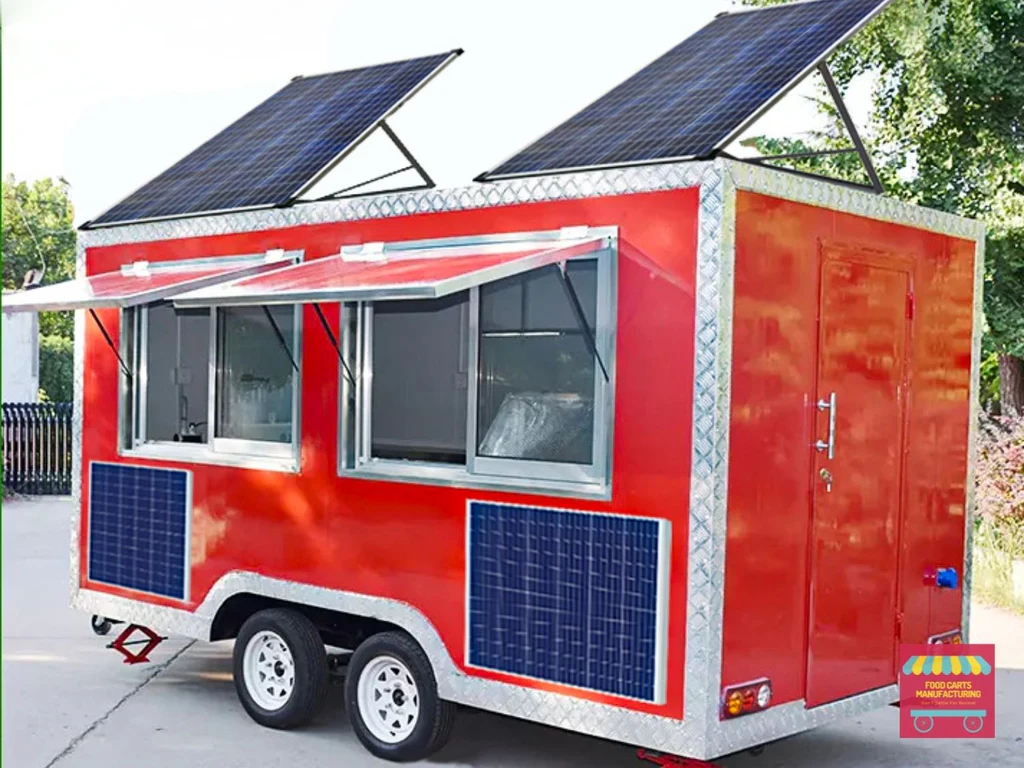Running a food truck is exciting, but keeping the lights, refrigerators, and cooking equipment running isn’t always easy. Relying on noisy generators and expensive fuel eats into profits. That’s why many owners are turning to solar panels for food truck setups — a cleaner, quieter, and cost-saving solution.

Why Use Solar Panels on a Food Truck?
Switching to solar power isn’t just a trend. It’s a smart business move. According to the U.S. Department of Energy, renewable energy solutions like solar can reduce operational costs by up to 30% over time. For food truck owners, this means more savings and less stress about finding electrical hookups or burning through fuel.
Read too: Franklin Truck Parts Near Me: Your Complete Guide to Local Truck Parts & Repair Solutions
Key benefits include:
- Lower operating costs: Sunlight is free once your system is installed.
- Eco-friendly branding: Customers love supporting sustainable businesses.
- Reduced noise: Solar systems are silent compared to gas generators.
- Energy independence: Operate anywhere, even without grid access.
How Many Solar Panels Does a Food Truck Need?
The number of panels depends on your daily energy usage. Let’s break it down:
- Calculate energy demand: Add up the wattage of all appliances (e.g., fridge, lights, cooking equipment).
- Example: Refrigerator (400W) + Lighting (100W) + POS system (50W) + Ventilation (200W) = 750W.
- Estimate daily use: Multiply total watts by hours used.
- If 750W runs for 8 hours → 6,000Wh (6kWh).
- Size your system: With standard 300W panels producing about 1.2kWh/day, you’d need about 5 panels to cover 6kWh.
Tip: Always oversize slightly to account for cloudy days and battery storage.
Costs of Installing Solar Panels for Food Trucks
Initial investment:
- Panels: $150–$300 each
- Inverter: $500–$1,000
- Batteries: $800–$3,000 (depending on capacity)
- Professional installation: $1,000–$2,500
Total estimated cost: $4,000–$8,000
While this may sound high, the payoff comes from eliminating fuel costs (often $30–$50 daily) and maintenance fees on traditional generators.
Solar Panels vs. Gas Generators: Which Is Better?
| Feature | Solar Panels | Gas Generators |
|---|---|---|
| Noise | Silent | Loud and disruptive |
| Fuel cost | Free after setup | $30–$50/day |
| Eco impact | Clean, renewable | Emits CO₂ and fumes |
| Maintenance | Low (cleaning, occasional check) | Frequent servicing needed |
| Startup cost | Higher | Lower |
Verdict: If you’re in it for the long run, solar pays off both financially and environmentally.
Steps to Install Solar Panels on Your Food Truck
- Assess power needs using wattage of appliances.
- Choose panels (flexible or rigid) based on available roof space.
- Select an inverter to convert solar energy into usable AC power.
- Add batteries for nighttime or cloudy-day use.
- Install securely with mounting brackets, ensuring panels face maximum sunlight.
- Work with a professional to ensure wiring and safety compliance.
Expert Insights
Dr. Fatih Birol, Executive Director of the International Energy Agency, notes: “Solar is set to become the new king of electricity, driven by its cost advantages and flexibility.” This trend extends to small businesses like food trucks, where portability and independence matter most.
For more technical background, you can check the basics of solar power on Wikipedia.
FAQ: Solar Panels for Food Trucks
1. Can solar panels run all appliances in my food truck?
Yes, if sized correctly. Large appliances like fryers or griddles may require extra batteries or a hybrid system combining solar with limited generator use.
2. How long do solar panels last?
Most panels last 20–25 years, with warranties covering efficiency for at least two decades.
3. Are solar panels safe during rainy or cloudy weather?
Absolutely. Panels still generate some energy in low light, but battery storage is crucial to keep operations smooth.
4. Do I need professional installation?
While DIY is possible, professional installers ensure safety, code compliance, and efficiency — especially with high-power appliances.
5. How long before I see return on investment (ROI)?
Typically 2–4 years, depending on your energy use and local sunlight conditions.
Conclusion
Adding solar panels for food truck operations transforms your business into a cost-efficient, eco-friendly powerhouse. You’ll spend less on fuel, attract more environmentally conscious customers, and enjoy quieter working conditions.
Leave a Reply